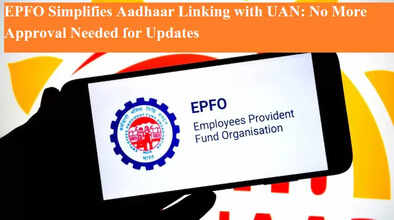EPFO Simplifies Aadhaar Linking with UAN: No More Approval Needed for Updates

In a move that will bring relief to millions of employees across India, the Employees’ Provident Fund Organisation (EPFO) has streamlined the process of linking and updating Aadhaar details with the Universal Account Number (UAN). With this new rule, members will no longer need repeated approvals from EPFO to update their information, making the process faster, smoother, and more employee-friendly.
The announcement was made through a circular issued on August 13, 2025, and it has been welcomed as a significant step towards reducing paperwork and delays.
What’s New in the Process?
Until now, employees had to depend heavily on EPFO’s manual approval process to update or correct Aadhaar details in their UAN records. This often caused delays and confusion. Under the revised rules, the process is much simpler:
-
If the name, gender, and date of birth in the employee’s UAN records match with the Aadhaar database, the employee only needs to approach their employer.
-
The employer can then complete the Aadhaar seeding directly through the KYC portal without requiring separate EPFO approval.
-
This means employees no longer have to wait for EPFO’s manual intervention, saving both time and effort.
The change makes Aadhaar linking and updates quicker and more transparent, reducing the dependency on bureaucratic procedures.
What Happens If Details Don’t Match?
One of the most common challenges employees face is a mismatch between Aadhaar details and UAN records. For example, discrepancies in the spelling of a name, gender information, or date of birth often caused rejections in the past.
With the new system, employers can now raise requests directly through the Joint Declaration (JD) portal to update such information online. Previously, this required a manual submission, which was time-consuming and often led to delays in account updates.
What If the Wrong Aadhaar Was Linked?
Sometimes, employees or employers mistakenly link the wrong Aadhaar number with a UAN. This created significant issues in accessing EPF services.
Now, under the revised procedure, the employer can simply update the correct Aadhaar number via the JD portal and send it directly to the local EPFO office. Once approved, the correct Aadhaar will be linked to the UAN, resolving the issue more efficiently than before.
Why Is This Change Important?
EPFO first introduced Aadhaar seeding in 2014 to simplify access to provident fund benefits and reduce dependence on employers. However, the approval-heavy process often became a hurdle rather than a convenience.
By decentralizing the procedure and empowering employers to handle Aadhaar-related updates directly, EPFO has made the system more user-friendly. This will help:
-
Employees – who can now easily update their records without prolonged delays.
-
Employers – who can quickly correct errors online instead of waiting for EPFO approval.
-
EPFO itself – which can reduce its administrative workload and focus on other services.
This change is expected to benefit millions of employees across the country, ensuring they can continue to access provident fund benefits without interruptions caused by data mismatches.
Conclusion
The latest update from EPFO marks a significant milestone in making employee services simpler and more efficient. By removing the need for constant approvals and allowing employers to manage Aadhaar seeding through online platforms, the organization has cut red tape and reduced the scope for delays.
For employees, this means less stress, faster updates, and uninterrupted access to provident fund benefits. For employers, it means greater autonomy in managing employee records. Overall, the change highlights EPFO’s push toward digital efficiency and employee convenience in 2025.

